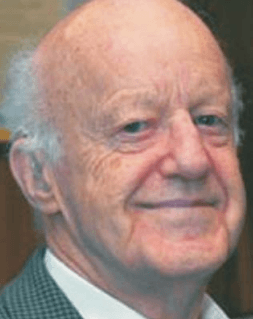Richard Dalitz facts for kids
Quick facts for kids
Dick Dalitz
|
|
|---|---|
 |
|
| Born |
Richard Henry Dalitz
28 February 1925 Dimboola, Australia
|
| Died | 13 January 2006 (aged 80) Oxford, England
|
| Nationality | Australian, British |
| Alma mater | Melbourne University University of Cambridge |
| Known for | Dalitz plot Dalitz pair CDD poles |
| Awards |
|
| Scientific career | |
| Fields | Particle physics Quantum mechanics |
| Institutions | University of Bristol University of Birmingham Cornell University Enrico Fermi Institute University of Oxford |
| Thesis | Zero-zero transitions in nuclei (1950) |
| Doctoral advisor | Nicholas Kemmer |
| Doctoral students | Frank Close Christopher Llewellyn Smith Crispin Gardiner |
Richard Henry Dalitz (February 28, 1925 – January 13, 2006) was an Australian physicist. He was famous for his important work in particle physics. This field studies the tiny building blocks of the universe.
Contents
Becoming a Scientist: Early Life and School
Richard Dalitz was born in Dimboola, Australia. He studied physics and math at Melbourne University. In 1946, he moved to the United Kingdom. There, he continued his studies at the University of Cambridge. He earned his PhD in 1950. His research was about how atomic nuclei change.
Discovering New Things: His Career in Physics
After getting his PhD, Dalitz worked at several universities. He taught and researched at places like the University of Bristol and University of Birmingham. He also worked in the United States at Cornell University and the Enrico Fermi Institute in Chicago. Later, he became a professor at the University of Oxford in England. He retired from his work in 1990.
Understanding Particle Behavior
Dalitz made several big discoveries in particle physics. One of them is called a Dalitz pair. This is when a certain particle breaks down into a photon and an electron-positron pair. He also created something called the Dalitz plot. This is a special graph that helps scientists understand how particles decay. He discovered these plots in 1953.
Dalitz plots are still very important today. Scientists use them to find new particles. For example, they were used in the search for the Higgs boson. They also help explore ideas beyond the Standard Model of physics. The Standard Model explains how the basic forces and particles in the universe work.
Many scientists consider Dalitz one of the "greatest unsung scientists" in particle physics. This means his work was very important, even if he wasn't always famous. Experimental scientists especially valued his ideas.
Exploring Quantum Mechanics
Dalitz was good friends with another famous physicist, John Clive Ward. They worked together on ideas in quantum mechanics. This is the part of physics that studies how tiny particles behave.
Dalitz helped explain how two photons (light particles) can be connected. This connection is called quantum entanglement. It means that even if the photons are far apart, they are linked. What happens to one can affect the other instantly. Dalitz showed that experiments agreed with quantum mechanics, not with older ideas about how things should work locally.
Working with Quarks
Dalitz was also involved in early research on quarks. Quarks are even smaller particles that make up protons and neutrons. In the 1960s, many scientists thought quarks were just mathematical ideas. But Dalitz took them seriously. He gave lectures about quark physics that became very important. He even helped identify the top quark, which is a type of quark.
Sharing His Knowledge: Publications
Throughout his life, Dalitz wrote many scientific papers. He published over 200 articles. He also wrote book reviews and gave public lectures. He worked with many other famous scientists. Some of his collaborators included Hans Bethe and Freeman Dyson.
Awards and Special Honors
Richard Dalitz received many awards for his work. In 1960, he became a Fellow of the Royal Society. This is a very high honor for scientists in the UK. He also received the Hughes Medal in 1975. This award was for his important contributions to understanding the basic particles of matter. Other awards he received include the Maxwell Medal and Prize and the Royal Medal.

